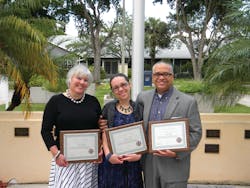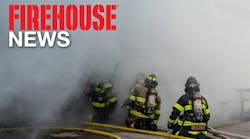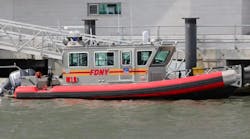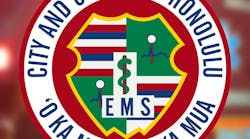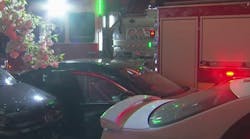DBFR Presents Life Saving Award to Family
The Delray Beach Fire-Rescue (DBRF) recently honored the Diaz family for their efforts on a call on April 12. The family witnessed a motor vehicle drive off the road and come to a stop against a fence hundreds of feet from the roadway. They stopped to render aid and ended up performing CPR as well as assisting DBFR crews in the treatment and movement of the patient to the transport Medic Unit. For their efforts, Jude, Rachel and Chesna Diaz were given the Life Saving Award, the highest award possible for a civilian from DBFR.
The Amazing Race(rs)
Firefighter Jazz Doolittle, a mother of two and cancer survivor, recently finished the Swamphouse Half Marathon in her firefighter gear, including air tank and helmet.
Doolittle is a member of the Seminole County Fire Department and Team Firefighter. Beginning in 2012, Team Firefighter selected Code 3 For A Cure as the main organization they support, and they encourage all firefighters to join this organization, which is dedicated to providing support to firefighters who want to better themselves through fitness in sport. Doolittle will continue to compete in marathons across the country to bring attention to her cause for hope and honor. Meanwhile, Firefighter Katrina Silvia (St. Johns County Fire Rescue, FL) recently competed in the Ironman Florida. After swimming 2.4 miles and biking 112, she donned her turnout gear for the 26.2 mile marathon portion of the event. Because of her extraordinary athletic abilities and efforts for Code 3 For A Cure, she received special recognition from Florida State Governor Richard Lynn Scott. Firefighter Silvia, who says one of her biggest challenges is to pass out Code 3 fliers during her races without getting sweat on them, has been selected by Code 3 for a Cure as the organization’s 2013 National Ambassador.
As mentioned, both firefighters were racing for Code 3 For A Cure, which provides financial assistance to firefighters across the country who are diagnosed with cancer and are facing a financial hardship. The CODE 3 fire truck carries a memorial fire bell on the empty seat, which signifies the loss of a firefighter to cancer. Please visit their website (www.code3foracure.org) for more information.
10 Tips to Save Lives
The National Fire Protection Association’s (NFPA’s) new report on home fires shows that U.S. fire departments responded to an estimated annual average of 366,600 home structure fires from 2007-2011. Seven people died each day in U.S. home fires. To help reduce these numbers, we offer the top ten fire safety tips from NFPA:
- Watch your cooking – Stay in the kitchen when you are frying, grilling, or broiling food. If you must leave, even for a short time, turn off the stove. If you are simmering, baking, roasting, or boiling food, check it regularly, remain in the home while food is cooking, and use a timer.
- Give space heaters space – Keep fixed and portable space heaters at least three feet from anything that can burn. Turn off heaters when you leave the room or go to sleep.
- Smoke outside – Ask smokers to smoke outside. Have sturdy, deep ashtrays for smokers.
- Keep matches and lighters out of reach – Keep matches and lighters up high, out of the reach of children, preferably in a cabinet with a child lock.
- Inspect electrical cords – Replace cords that are cracked, damaged, have broken plugs, or loose connections.
- Be careful when using candles – Keep candles at least one foot from anything that can burn. Blow out candles when you leave the room or go to sleep.
- Have a home fire escape plan – Make a home fire escape plan and practice it at least twice a year.
- Install smoke alarms – Install smoke alarms on every level of your home, inside bedrooms and outside sleeping areas. Interconnect smoke alarms throughout the home. When one sounds, they all sound. For the best protection, both ionization and photoelectric alarms or combination ionization and photoelectric alarms (also known as dual sensor alarms) are recommended.
- Test smoke alarms – Test smoke alarms at least once a month and replace conventional batteries once a year or when the alarm “chirps” to tell you the battery is low. Replace any smoke alarm that is more than 10 years old.
- Install sprinklers – If you are building or remodeling your home, install residential fire sprinklers. Sprinklers can contain and may even extinguish a fire in less time than it would take the fire department to arrive.
Visit www.nfpa.org/safetytips to learn more and access free downloadable resources.
This Month in Fire History
July 5, 1973, Kingman AZ – Doxol Gas Co. fire kills 12 firefighters
July 6, 1944, Hartford, CT – Ringling Bros., Barnum & Bailey Circus tent fire kills 168
July 7, 1975, Portland, OR – Pomona Hotel fire kills 12
July 9, 1953, Mendocino National Forest, CA – Forest fire kills 15 firefighters
July 23, 1984, Romeoville, IL – Union Oil refinery fire kills 17; losses worth $177 million
July 24, 1931, Pittsburgh, PA – Little Sisters of the Poor home for the aged fire kills 48
July 26, 1990 – Americans with Disabilities Act passes, greatly affecting safety codes
July 28, 1945, New York, NY – Fire after B-25 crash into Empire State Building kills 14
July 29, 1956, Sun Ray, TX – Shamrock Oil & Gas corp. refinery fire kills 19 firefighters
Courtesy of NFPA
For details on fires that occurred 100 years ago this month, turn to Paul Hashagen’s “Rekindles” on page XXX.
